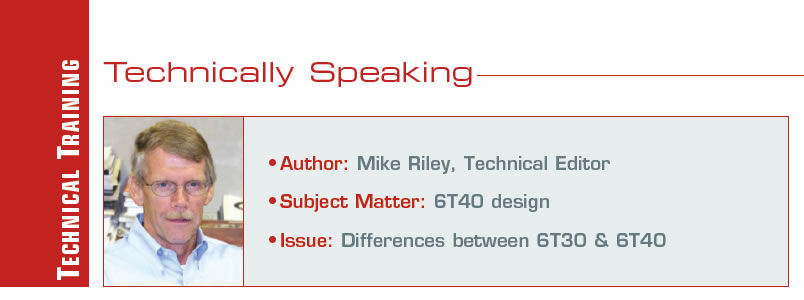
Technically Speaking
- Author: Mike Riley, Technical Editor
- Subject Matter: 6T40 design
- Issue: Differences between 6T30 & 6T40
Technical Training
The “breaking news” of today is of course the launching of a brand-new RWD 10-speed automatic transmission being jointly developed by Ford and General Motors. The previous joint venture involving the two automakers was to develop a FWD six-speed automatic gearbox but that is now a distant memory. How time flies.
During development, the GM 6T70 and Ford 6F50 basically fell off the same sheet of paper resulting in a noticeable amount of interchangeability of various components. One key difference between the two models is that GM chose to go with a mechatronic (TEHCM) valve body design, whereas Ford stuck with the traditional external TCM (PCM). Another variable between the GM and Ford transmissions were the dreaded cushion springs that have been tweaked over the years. Both designs accommodate the larger vehicles equipped with higher output engines and both have received continuous changes and upgrades.
To accommodate lighter-duty vehicles equipped with smaller engines, another level of transmission was required, resulting in the launch of the GM 6T40 and Ford 6F35 a short time later. Unlike the 6T70 / 6F50 scenario, the marriage between the 6T40 and 6F35 was less complementary due to the fact that virtually nothing will interchange between the two units. Beyond basic layout, each manufacturer went their own way concerning individual component sourcing and design.
The main functional differences between the large transmissions (6T70 / 6F50) and the smaller transmissions (6T40 / 6F35) is in pump design, remote axis vs. direct drive and a gear-driven vs. chain-driven final drive assembly. Overall, component size also differs between the two design levels and of course assembly procedures are substantially different. With all of these variables, one would think that vehicle requirements relating to transmission types would be satisfied; however, one would be wrong.
Apparently, someone at GM decided that another level of six-speed transmission was needed, and so engineers went to work to develop what could be considered a mini six-speed automatic to fill the bill. Using the 6T40 architecture, the 6T30 (MH9) was developed to accommodate certain vehicle attributes that in some cases makes little sense. Normally, a vehicle such as a Chevy Cruze equipped with a 1.8L engine might require a 6T40 transmission, whereas, if equipped with a 1.4L engine, it would require the smaller 6T30; however, such is not the case. The manufacturer choice of transmission can overlap for various reasons, which is another example of the importance of the VIN #. Assume nothing.
Although the 6T30 was initially launched in 2009, domestic usage had been minimal. The transmission design has certainly gained traction in other parts of the world, such as China, which tend to utilize vehicles with lower output engines. Over the last few years, however, more domestic vehicles are using the 6T30, which means more parts sourcing to contend with. The upside is that diagnostics is comparable to dealing with the 6T40 so trouble shooting should not be an issue. The majority of domestic 6T30 involvement will be working with the GEN 2 design mechatronic valve body and other GEN 2 items.

Distinguishing the 6T30 from the 6T40 externally is not too difficult but it always pays to validate the models by using the transmission codes. Unit coding aside, one surefire way to discern a 6T30 from a 6T40 is by the bell housing-to-case configuration. The 6T30 uses a bell-to-case gasket that has 16 holes whereas the 6T40 gasket has 17 holes (figures 1A and 1B).
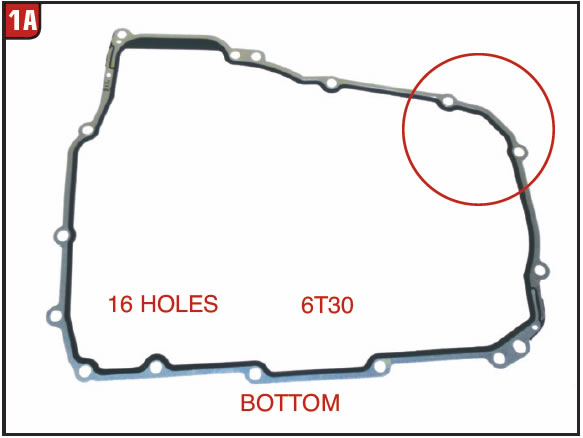
The upper left corner of the bell housing is where the extra bolt hole is located as viewed from the front of the transmission. In addition, the spacing of the five bolt holes along the bottom edge of the bell-to-case surface is different between the two models. The back end of the case of the 6T30 is also smaller. As expected, the torque converter is a runt compared to a 6T40 converter along with a different turbine spline count.

Valve body/cover: Although the vast majority of the stuff within a 6T30 is unique, there are some items common to both models of transmissions. The first item to stick out like a sore thumb is the valve body cover and gasket which happens to be the same as the 6T40 (Figure 2). The plastic cover and spaghetti seal has been relatively unchanged, although the electrical connector-to-cover bathtub seal did get a facelift and is interchangeable.
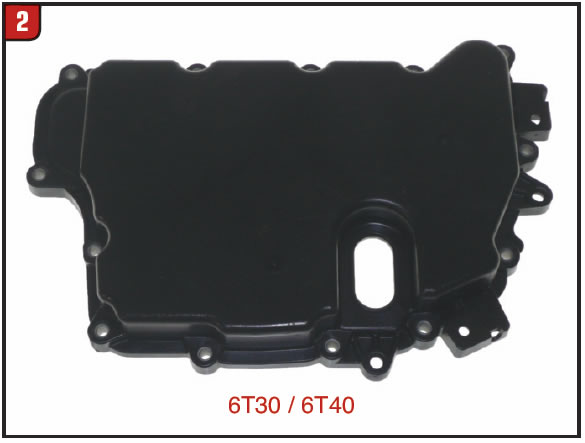

TEHCM: With the valve body cover out of the way, one of the most important components of the transmissions is exposed, which is the TEHCM assembly. With all of the software calibration concerns, who would’ve thought that GM would use the same TEHCM for both the 6T30 and 6T40 (Figure 3). The TEHCM illustrated is the GEN 2 design, meaning no pressure switches, as is the case for later applications. Always verify the correct part number based upon the specific vehicle to avoid problems.

Valve body: The situation with the valve body is not so cut and dry, due to the overall configuration (Figure 4). Although the bolt spacing and appearance at first glance may lead someone to think that the two models are interchangeable, a close examination of the worm tracks will clarify the difference.
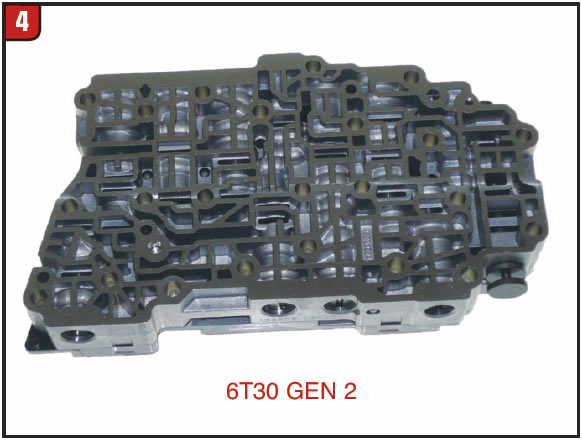
Valve body calibration will also vary between models. Add in design differences that have occurred over the years and potential for disaster could happen by using the wrong valve body. The separator plates are in the same boat and for the same reason, different oil holes and different part numbers.

Sensors: GM did decide that when it came to switches and sensors they would cut everybody a break and stick with the basics. The remaining items of concern in the valve body area are the ISS, OSS and IMS (internal mode switch) and fortunately they are the same between 6T30 and 6T40 models (Figure 5). Another bonus item common to both models is the fluid level thermal assembly, go figure.
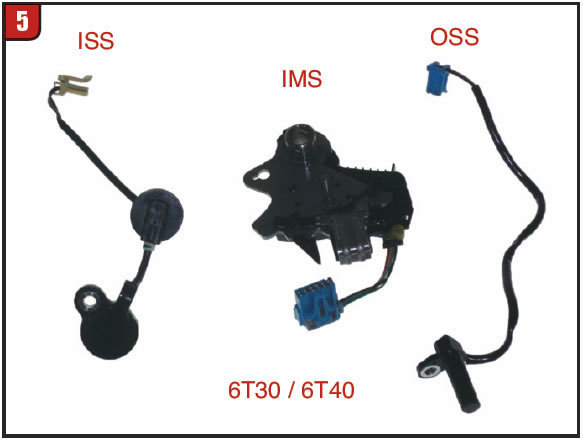
Bell housing section: With the valve body items out of the way, the focus can turn to internal components starting with items that are attached to the bell housing. The 6T30 disassembly procedure is the same as a 6T40 beginning with splitting the bell housing from the main case. With the bolts removed, the bell housing and stuff can be separated from the case even with the valve body and cover in position, however, it’s not light.
Pump: A key hard part that overlaps between a 6T30 and 6T40 is the pump assembly, kind of. GM did decide to utilize the aluminum pump body from the 6T40 (Figure 6A). As is normally the case, minor calibration differences can exist with the valves or springs. The main concern is whether the pump body is for a GEN 1 or GEN 2 application due to a regulator valve modification. Always check valve small land diameter and spring tension before interchanging the pump body. The stator support is another matter altogether. Although the stator support used for both models look alike, they’re not.
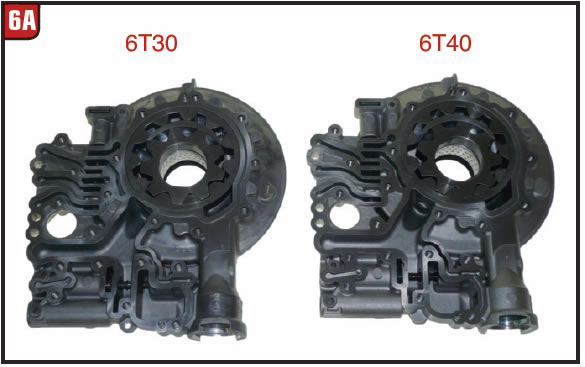
The hold down bolt pattern is almost the same, but the 6T40 has one extra bolt (Figure 6B). Most important is the thickness of the stator support where the case multi-seal makes contact. The 6T30 support is approximately ¼-inch thinner than the 6T40, which would make for a major leak. The easiest way to tell one support from the other is the input shaft bore which is smaller on the 6T30. Always check the input shaft to bushing clearance to avoid cross leaks.
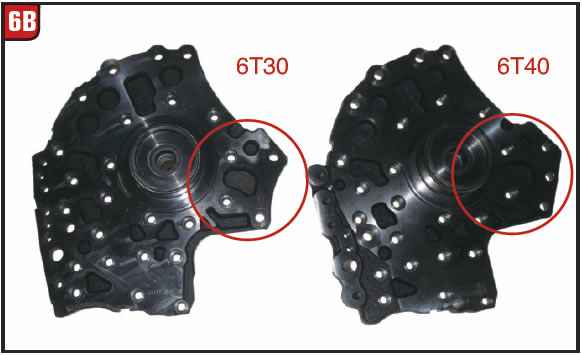

Input shaft: Due to the decreased torque capacity requirements, the 6T30 input shaft is smaller in diameter than the 6T40 input, (Figure 7). As if removing the small snap ring from the end of the shaft on the 6T40 wasn’t bad enough, the 6T30 snap ring is even worse due to it being smaller, which means sharpen up the scribes. One issue that did occur on the 6T30 input shaft was the shaft breaking in two due to a production problem mainly with 2012 models. It would be advisable while rebuilding a 6T30 that the input shaft be replaced. The OE part number is 24231696.
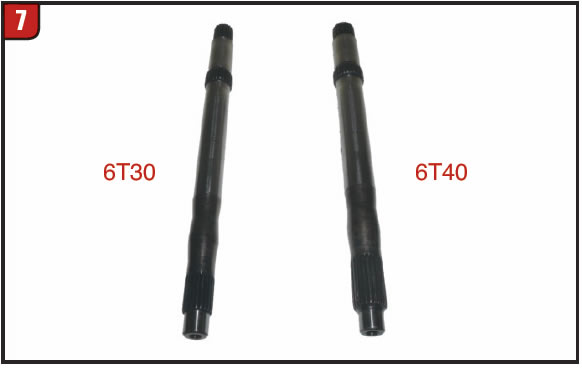
Filter: Of all the components in a transmission scenario like this it is the filter that should be common between the models although that is not the case.
Apparently bonus points are given for the development of each new filter because there certainly is a ton of them including the 6T30 (Figure 8). Not only is the interlock outlet in a different position, but the spacing and length of the inlet is different as well. At least both styles have magnets.
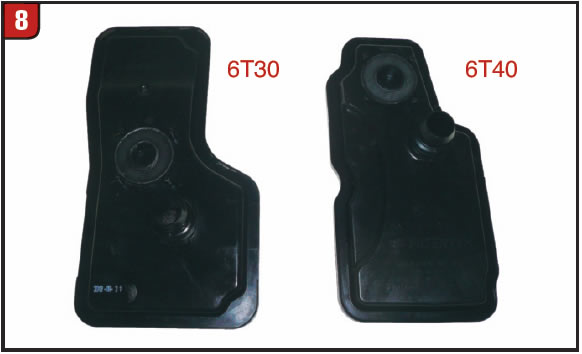
Final drive assembly: The 6T30 final drive assembly is the traditional GM planetary design that is also used in the 6T40, unlike the ring and pinion design used in 6T70 models. Like most other hard parts used in the 6T30 the final drive assembly is a shrimp, comparatively speaking, (Figure 9).
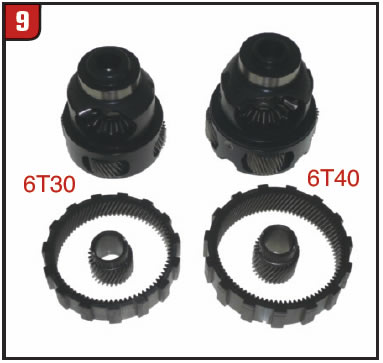
The ring gear splines to the bell housing and the final drive carrier sets in the housing cavity. Unlike a lot of other small items used in the 6T30, the final drive carrier bushing does happen to be the same between the two models. That’s one for the team.















